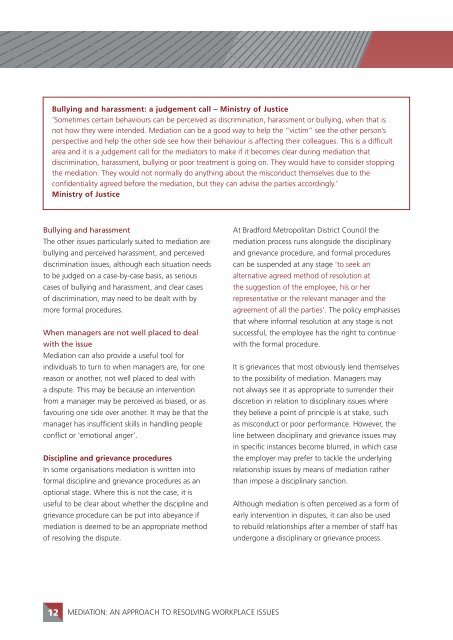Mediation: an approach to resolving workplace issues - CIPD
Mediation: an approach to resolving workplace issues - CIPD
Mediation: an approach to resolving workplace issues - CIPD
Create successful ePaper yourself
Turn your PDF publications into a flip-book with our unique Google optimized e-Paper software.
Bullying <strong>an</strong>d harassment: a judgement call – Ministry of Justice<br />
‘Sometimes certain behaviours c<strong>an</strong> be perceived as discrimination, harassment or bullying, when that is<br />
not how they were intended. <strong>Mediation</strong> c<strong>an</strong> be a good way <strong>to</strong> help the “victim” see the other person’s<br />
perspective <strong>an</strong>d help the other side see how their behaviour is affecting their colleagues. This is a difficult<br />
area <strong>an</strong>d it is a judgement call for the media<strong>to</strong>rs <strong>to</strong> make if it becomes clear during mediation that<br />
discrimination, harassment, bullying or poor treatment is going on. They would have <strong>to</strong> consider s<strong>to</strong>pping<br />
the mediation. They would not normally do <strong>an</strong>ything about the misconduct themselves due <strong>to</strong> the<br />
confidentiality agreed before the mediation, but they c<strong>an</strong> advise the parties accordingly.’<br />
Ministry of Justice<br />
Bullying <strong>an</strong>d harassment<br />
The other <strong>issues</strong> particularly suited <strong>to</strong> mediation are<br />
bullying <strong>an</strong>d perceived harassment, <strong>an</strong>d perceived<br />
discrimination <strong>issues</strong>, although each situation needs<br />
<strong>to</strong> be judged on a case-by-case basis, as serious<br />
cases of bullying <strong>an</strong>d harassment, <strong>an</strong>d clear cases<br />
of discrimination, may need <strong>to</strong> be dealt with by<br />
more formal procedures.<br />
When m<strong>an</strong>agers are not well placed <strong>to</strong> deal<br />
with the issue<br />
<strong>Mediation</strong> c<strong>an</strong> also provide a useful <strong>to</strong>ol for<br />
individuals <strong>to</strong> turn <strong>to</strong> when m<strong>an</strong>agers are, for one<br />
reason or <strong>an</strong>other, not well placed <strong>to</strong> deal with<br />
a dispute. This may be because <strong>an</strong> intervention<br />
from a m<strong>an</strong>ager may be perceived as biased, or as<br />
favouring one side over <strong>an</strong>other. It may be that the<br />
m<strong>an</strong>ager has insufficient skills in h<strong>an</strong>dling people<br />
conflict or ‘emotional <strong>an</strong>ger’.<br />
Discipline <strong>an</strong>d griev<strong>an</strong>ce procedures<br />
In some org<strong>an</strong>isations mediation is written in<strong>to</strong><br />
formal discipline <strong>an</strong>d griev<strong>an</strong>ce procedures as <strong>an</strong><br />
optional stage. Where this is not the case, it is<br />
useful <strong>to</strong> be clear about whether the discipline <strong>an</strong>d<br />
griev<strong>an</strong>ce procedure c<strong>an</strong> be put in<strong>to</strong> abey<strong>an</strong>ce if<br />
mediation is deemed <strong>to</strong> be <strong>an</strong> appropriate method<br />
of <strong>resolving</strong> the dispute.<br />
At Bradford Metropolit<strong>an</strong> District Council the<br />
mediation process runs alongside the disciplinary<br />
<strong>an</strong>d griev<strong>an</strong>ce procedure, <strong>an</strong>d formal procedures<br />
c<strong>an</strong> be suspended at <strong>an</strong>y stage ‘<strong>to</strong> seek <strong>an</strong><br />
alternative agreed method of resolution at<br />
the suggestion of the employee, his or her<br />
representative or the relev<strong>an</strong>t m<strong>an</strong>ager <strong>an</strong>d the<br />
agreement of all the parties’. The policy emphasises<br />
that where informal resolution at <strong>an</strong>y stage is not<br />
successful, the employee has the right <strong>to</strong> continue<br />
with the formal procedure.<br />
It is griev<strong>an</strong>ces that most obviously lend themselves<br />
<strong>to</strong> the possibility of mediation. M<strong>an</strong>agers may<br />
not always see it as appropriate <strong>to</strong> surrender their<br />
discretion in relation <strong>to</strong> disciplinary <strong>issues</strong> where<br />
they believe a point of principle is at stake, such<br />
as misconduct or poor perform<strong>an</strong>ce. However, the<br />
line between disciplinary <strong>an</strong>d griev<strong>an</strong>ce <strong>issues</strong> may<br />
in specific inst<strong>an</strong>ces become blurred, in which case<br />
the employer may prefer <strong>to</strong> tackle the underlying<br />
relationship <strong>issues</strong> by me<strong>an</strong>s of mediation rather<br />
th<strong>an</strong> impose a disciplinary s<strong>an</strong>ction.<br />
Although mediation is often perceived as a form of<br />
early intervention in disputes, it c<strong>an</strong> also be used<br />
<strong>to</strong> rebuild relationships after a member of staff has<br />
undergone a disciplinary or griev<strong>an</strong>ce process.<br />
12<br />
MEDIATION: AN APPROACH TO RESOLVING WORKPLACE ISSUES

















